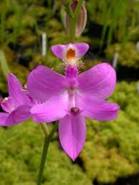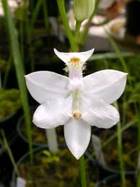

(Protocol to Produce 2 year old corms)
General Information
The seed of this species was obtained from plants grown by Cypripediums.com.The pink flowered form was purchased from Meadowview Biological Research Station in Virginia. The white form called "alba" was purchased from a now closed Sarracenia grower in the South. For producing the "alba" form seeds was generated by crossing two white individuals. The pink form was produced by crossing two pink forms. This species is found in damp meadows, fens, and marshes on chalk or limestone soils. Soil pH is apparently not important as long as a damp environment is provided. Likes full sun. Grows well in an artificial bog in full sun with dead long-fibered peat overlain with living Sphagnum moss.
Plating Media: R medium + 2 uM metaTopolin + 4, 1 cm3 cubes Russet potato sliced in quarters. 15 mins. 0.525% Chlorox bleaching (no charcoal). Mature seeds were plated 12/21/10 on 150 mm petri dishes containing 100 ml of media. Plates were sealed with parafilm and incubated under fluorescent lights at room temperature ( approx. 23-26 o C). In less than 2 weeks green protocorms were visible. Mature Calopogon seed has no germination inhibitors, the chlorox bleaches' only function is to sterilize the seed surface against infections by fungi and bacteria.
Number of Days between Plating and Replating: 58 days
Replating Media: R medium + 1, 1 cm3 cube Russet potato sliced in quarters. No charcoal is necessary in the replate media as the roots in the above media do not release phenolic compounds. Replating was done in wide mouth pint jars containing 200 ml of media on Feb. 17, 2011. Replates were grown for approximately 11 months and examined on Oct. 13, 2011 at which time they were placed in the frig at 4oC. in darkness. By this date the leaves started to turn brown and senesce. They were kept in the dark frig for 3.5 months until Jan. 27, 2012. They were removed from the frig on Jan. 27, 2012 and kept at room temperature under fluorescent lights for 6+ months until July 27, 2012 when they were returned to the 4o C frig in the dark. After 6+ months some, but not all, of the seedlings started to senesce. One could continue to grow those plants that had not senesced for more than 6+ months before returning them to the frig. After 2 growth periods in the lights the corms ranged from about 1/8 inch to about 0.5 inches.
Number of Days between Replating and first Vernalization: 11 months
Number of Days between start and end of first Vernalization: 3.5 months
Number of Days between 2nd growth period and 2nd Vernalization: 6-8 months
Numbers of Days of 2nd Vernalization: 8 months (One could plant out the corms after about 4 months if kept indoors away from freezing).
Date to Initiate Plating: Dec. 21
Date to Replate and Keep under lights (first growth period): Feb. 17
Date to start the First Vernalization in Frig in Darkness: Oct. 13
Date to start 2nd growth period under lights at room temperature: Jan. 27
Date to start 2nd vernalization in Frig. in Darkness: Aug. 1 to Sept. 30
Date to remove from frig, outplant to media, and grow with light: March 1-April 1
Results after 2nd Vernalization: well developed protocorms up to 0.5 inches diameter.
Results After Outplanting in Media: Outplanting to dead long-fibered sphagnum in artificial bog-- plants grew well.

